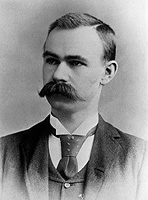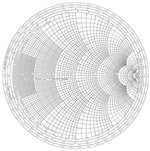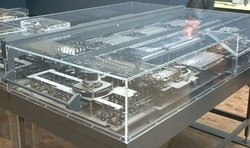History of computing hardware
|
|
| History of computing |
| Before 1960 |
| 1960s to present |
| Operating systems |
| Timeline
|
Computing hardware has been an essential component of the process of calculation and data storage since it became useful for numerical values to be processed and shared. The earliest computing hardware was probably some form of tally stick; later recording devices include the Phoenician clay shapes which represented counts of items, probably livestock or grains, in containers. These seem to have been used by the merchants, accountants, and government officials of the time.
Devices to aid computation have evolved from simple recording and counting devices through the abacus, the slide rule, and more recent electronic computers. Even today, an experienced abacus user using a device designed hundreds of years ago can sometimes complete basic calculations more quickly than an unskilled person using an electronic calculator — though for more complex calculations, computers out-perform even the most skilled human.
This article presents the major developments in the history of computing hardware and attempts to put them in context. For a detailed timeline of events, see the computing timeline article. The history of computing article is a related overview and treats methods intended for pen and paper, with or without the aid of tables.
| Contents |
Earliest devices for facilitating human calculation
Humanity has used devices to aid in computation for millennia. One example is a device for establishing equality by weight: the classic scales, later used to symbolize equality in justice. Another is simple enumeration: the checkered cloths of the counting houses served as simple data structures for enumerating stacks of coins, by weight. A more arithmetic-oriented machine is the abacus. One of the earliest machines of this type was the Chinese abacus.
First mechanical calculators
In 1623 Wilhelm Schickard built the first mechanical calculator and thus became the father of the computing era. Since his machine used techniques such as cogs and gears first developed for clocks, it was also called a 'calculating clock'. It was put to practical use by his friend Johannes Kepler, who revolutionized astronomy.
Machines by Blaise Pascal (the Pascaline, 1642) and Gottfried Wilhelm von Leibniz (1671) followed. Around 1820, Charles Xavier Thomas created the first successful, mass-produced mechanical calculator, the Thomas Arithmometer, that could add, subtract, multiply, and divide. It was mainly based on Leibniz's work. Mechanical calculators, like the base-ten addiator, the comptometer, the Monroe, the Curta and the Addo-X remained in use until the twentieth century.
Monroecalculator.jpg
Leibniz also described the binary numeral system, a central ingredient of all modern computers. However, up to the 1940s, many subsequent designs (including Charles Babbage's machines of the 1800s and even ENIAC of 1945) were based on the harder-to-implement decimal system.
John Napier noted that multiplication and division of numbers can be performed by addition and subtraction, respectively, of logarithms of those numbers. Since these real numbers can be represented as distances or intervals on a line, the slide rule allowed multiplication and division operations to be carried significantly faster than was previously possible. Slide rules were used by generations of engineers and other mathematically inclined professional workers, until the invention of the pocket calculator. The engineers in the Apollo program to send a man to the moon made many of their calculations on slide rules, which were accurate to 3 or 4 significant figures.
While producing the first logarithmic tables Napier needed to perform many multiplications and it was at this point that he designed Napier's bones.
Punched card technology 1801–
In 1801, Joseph-Marie Jacquard developed a loom in which the pattern being woven was controlled by punched cards. The series of cards could be changed without changing the mechanical design of the loom. This was a landmark point in programmability.
In 1833, Charles Babbage moved on from developing his difference engine to developing a more complete design, the analytical engine which would draw directly on Jacquard's punch cards for its programming.
In 1890 the United States Census Bureau used punch cards and sorting machines designed by Herman Hollerith to handle the flood of data from the decennial census mandated by the Constitution. Hollerith's company eventually became the core of IBM. IBM developed punch card technology into a powerful tool for business data processing and produced an extensive line of specialized unit record equipment. By 1950 the IBM card had become ubiquitous in industry and government. The warning printed on most cards, "Do not fold, staple or mutilate," became a motto for the post-World War II era.
Leslie Comrie's articles on punch card methods and W.J. Eckert's publication of Punched Card Methods in Scientific Computation in 1940, described techniques which were sufficiently advanced to solve differential equations, perform multiplication and division using floating point representations, all on punched cards and plugboards similar to those used by telephone operators. The Thomas J. Watson Astronomical Computing Bureau, Columbia University performed astronomical calculations representing the state of the art in computing.
In many computer installations, punched cards were used until (and after) the end of the 1970s. For example, science and engineering students at many universities around the world would submit their programming assignments to the local computer centre in the form of a stack of cards, one card per program line, and then had to wait for the program to be queued for processing, compiled, and executed. In due course a printout of any results, marked with the submitter's identification, would be placed in an output tray outside the computer center. In many cases these results would comprise solely a printout of error messages regarding program syntax etc., necessitating another edit-compile-run cycle.
Punched cards are still used and manufactured in the current century, and their distinctive dimensions (and 80-column capacity) can still be recognised in forms, records, and programs around the world.
First designs of programmable machines 1835–1900s
The defining feature of a "universal computer" is programmability, which allows the computer to emulate any other calculating machine by changing a stored sequence of instructions.
In 1835 Charles Babbage described his analytical engine. It was the plan of a general-purpose programmable computer, employing punch cards for input and a steam engine for power. One crucial invention was to use gears for the function served by the beads of an abacus. In a real sense, computers all contain automatic abaci (technically called the ALU or floating-point unit).
While the plans were probably correct, or at least debuggable, the project was slowed by disputes with the artisan who built parts. It was ended with the depletion of government funding.
Ada Lovelace, Lord Byron's daughter, translated and added notes to the "Sketch of the Analytical Engine" by Federico Luigi, Conte Menabrea. She has become closely associated with Babbage. Some claim she is the world's first computer programmer, however this claim and the value of her other contributions are disputed by many.
A reconstruction of the Difference Engine II, an earlier, more limited design, has been operational since 1991 at the London Science Museum. With a few trivial changes, it works as Babbage designed it and shows that Babbage was right in theory.
The museum used computer-operated machine tools to construct the necessary parts, following tolerances which a machinist of the period would have been able to achieve. Some feel that the technology of the time was unable to produce parts of sufficient precision, however this appears to be false. The failure of Babbage to complete the engine can be chiefly attributed to difficulties not only related to politics and financing, but also to his desire to develop an increasingly sophisticated computer. Today, many in the computer field term this sort of obsession creeping featuritis.
Following in the footsteps of Babbage, although unaware of his earlier work, was Percy Ludgate, an accountant from Dublin, Ireland. He independantly designed a programmable mechanical computer, which he described in a work that was published in 1909.
More limited types of mechanical gear computing 1800s–1900s
By the 1900s earlier mechanical calculators, cash registers, accounting machines, and so on were redesigned to use electric motors, with gear position as the representation for the state of a variable. People were computers, as a job title, and used calculators (http://www.oldcalculatormuseum.com/fridenstw.html) to evaluate expressions. During the Manhattan project, future Nobel laureate Richard Feynman was the supervisor of the roomful of human computers, many of them women mathematicians, who understood the differential equations which were being solved for the war effort. Even the renowned Stanislaw Marcin Ulam was pressed into service to translate the mathematics into computable approximations for the hydrogen bomb, after the war.
In 1948, the Curta was introduced. This was a small, portable, mechanical calculator that was about the size of a pepper grinder. Over time, during the 1950s and 1960s a variety of different brands of mechanical calculator appeared on the market. With the improvement of electronic computers, however, the expensive, large mechanical calculator was soon replaced with smaller devices. To this day, an active collector community can be found on the internet and elsewhere.
Analog computers, pre-1940
Before World War II, mechanical and electrical analog computers were considered the 'state of the art', and many thought they were the future of computing. Analog computers use continuously varying amounts of physical quantities, such as voltages or currents, or the rotational speed of shafts, to represent the quantities being processed. An ingenious example of such a machine was the Water integrator built in 1936. Unlike modern digital computers, analog computers are not very flexible, and need to be reconfigured (i.e., reprogrammed) manually to switch them from working on one problem to another. Analog computers had an advantage over early digital computers in that they could be used to solve complex problems while the earliest attempts at digital computers were quite limited. But as digital computers have become faster and used larger memory (e.g., RAM or internal store), they have almost entirely displaced analog computers, and computer programming, or coding has arisen as another human profession.
Since computers were rare in this era, the solutions were often hard-coded into paper forms such as graphs and nomograms, which could then allow analog solutions to problems, such as the distribution of pressures and temperatures in a heating system.
Some of the most widely deployed analog computers included devices for aiming weapons, such as the Norden bombsight and artillery aiming computers for battleships. Some of these stayed in use for decades after WWII.
Hybrid analog computers, controlled by digital electronics, remained in substantial use into the 1950's and 1960's, and later in some specialised applications.
First generation of electrical digital computers 1940s

The era of modern computing began with a flurry of development before and during World War II, as electronic circuits, relays, capacitors and vacuum tubes replaced mechanical equivalents and digital calculations replaced analog calculations. The computers designed and constructed then have sometimes been called 'first generation' computers. First generation computers were usually built by hand using circuits containing relays or vacuum valves (tubes), and often used punched cards or punched paper tape for input and as the main (non-volatile) storage medium. Temporary, or working storage, was provided by acoustic delay lines (which use the propagation time of sound in a medium such as wire to store data) or by Williams tubes (which use the ability of a television picture tube to store and retrieve data). By 1954, magnetic core memory was rapidly displacing most other forms of temporary storage, and dominated the field through the mid-1970s.
In this era, a number of different machines were produced with steadily advancing capabilities. At the beginning of this period, nothing remotely resembling a modern computer existed, except in the long-lost plans of Charles Babbage and the mathematical musings of Alan Turing and others. At the end of the era, devices like the EDSAC had been built, and are universally agreed to be universal digital computers. Defining a single point in the series as the "first computer" misses many subtleties.
Alan Turing's 1936 paper has proved enormously influential in computing and computer science in two ways. Its main purpose was an elegant proof that there were problems (namely the halting problem) that could not be solved by a mechanical process (a computer). In doing so, however, Turing provided a definition of what a universal computer is: a construct called the Turing machine, a purely theoretical device invented to formalize the notion of algorithm execution, replacing Kurt Gödel's more cumbersome universal language based on arithmetics. Modern computers are Turing-complete (i.e., equivalent algorithm execution capability to a universal Turing machine), except for their finite memory. This limited type of Turing completeness is sometimes viewed as a threshold capability separating general-purpose computers from their special-purpose predecessors.
However, as will be seen, theoretical Turing-completeness is a long way from a practical universal computing device. To be a practical general-purpose computer, there must be some convenient way to input new programs into the computer, such as punched tape. For full versatility, the Von Neumann architecture uses the same memory both to store programs and data; virtually all contemporary computers use this architecture (or some variant). Finally, while it is theoretically possible to implement a full computer entirely mechanically (as Babbage's design showed), electronics made possible the speed and later the miniaturization that characterises modern computers.
There were three parallel streams of computer development in the World War II era, and two were either largely ignored or were deliberately kept secret. The first was the German work of Konrad Zuse. The second was the secret development of the Colossus computer in the UK. Neither of these had much influence on the various computing projects in the United States. After the war, British and American computing researchers cooperated on some of the most important steps towards a practical computing device.
American developments
In 1937, Claude Shannon produced his master's thesis at MIT that implemented Boolean algebra using electronic relays and switches for the first time in history. Entitled A Symbolic Analysis of Relay and Switching Circuits, Shannon's thesis essentially founded practical digital circuit design.
In November of 1937, George Stibitz, then working at Bell Labs, completed a relay-based computer he dubbed the "Model K" (for "kitchen", where he had assembled it), which calculated using binary addition. Bell Labs thus authorized a full research program in late 1938 with Stibitz at the helm. Their Complex Number Calculator, completed January 8, 1940, was able to calculate complex numbers. In a demonstration to the American Mathematical Society conference at Dartmouth College on September 11, 1940, Stibbitz was able to send the Complex Number Calculator remote commands over telephone lines by a teletype. It was the first computing machine ever used remotely over a phone line. Some participants of the conference who witnessed the demonstration were John Von Neumann, John Mauchly, and Norbert Wiener, who wrote about it in his memoirs.
In 1938 John Vincent Atanasoff and Clifford E. Berry of Iowa State University developed the Atanasoff Berry Computer (ABC), a special purpose computer for solving systems of linear equations, and which employed capacitors fixed in a mechanically rotating drum, for memory. The ABC machine was not programmable, though it was a computer in the modern sense in several other respects.
In 1939, development began at IBM's Endicott laboratories on the Harvard Mark I. Known officially as the Automatic Sequence Controlled Calculator, the Mark I was a general purpose electro-mechanical computer built with IBM financing and with assistance from some IBM personnel under the direction of Harvard mathematician Howard Aiken. Its design was influenced by the Analytical Engine. It was a decimal machine which used storage wheels and rotary switches in addition to electromagnetic relays. It was programmable by punched paper tape, and contained several calculators working in parallel. Later models contained several paper tape readers and the machine could switch between readers based on a condition. Nevertheless, this does not quite make the machine Turing-complete. The Mark I was moved to Harvard University to begin operation in May 1944.

The US-built ENIAC (Electronic Numerical Integrator and Computer), often called the first electronic general-purpose computer, publicly validated the use of electronics for large-scale computing. This was crucial for the development of modern computing, initially because of the enormous speed advantage, but ultimately because of the potential for miniaturization. Built under the direction of John Mauchly and J. Presper Eckert, it was 1,000 times faster than its contemporaries. ENIAC's development and construction lasted from 1941 to full operation at the end of 1945. When its design was proposed, many researchers believed that the thousands of delicate valves (i.e. vacuum tubes) would burn out often enough that the ENIAC would be so frequently down for repairs as to be useless. It was, however, capable of up to thousands of operations per second for hours at a time between valve failures.
ENIAC was unambiguously a Turing-complete device. To 'program' ENIAC, however, meant to rewire it - some say, this does not even qualify as programming, otherwise any type of rebuilding some limited computer might be viewed as programming. At the time, however, unaided calculation was seen as enough of a triumph, to view the solution of a single problem as the object of a program. Several years later, however, it became also possible to execute stored programs set in function table memory, which made programming less a one-off effort, and more systematic.
All machines at that date still lacked the von Neumann architecture:
Colossus
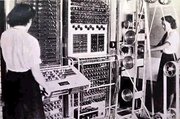
During World War II, the British at Bletchley Park achieved a number of successes at breaking encrypted German military communications. The German encryption machine, Enigma, was attacked with the help of electro-mechanical machines called bombes. The bombe, designed by Alan Turing and Gordon Welchman, after Polish bomba, ruled out possible Enigma settings by performing chains of logical deductions implemented electrically. Most possibilities led to a contradiction, and the few remaining could be tested by hand.
The Germans also developed a series of teleprinter encryption systems, quite different from Enigma. The Lorenz SZ 40/42 machine was used for high-level Army communications, termed "Tunny" by the British. The first intercepts of Lorenz messages begain in 1941. As part of an attack on Tunny, Professor Max Newman and his colleagues helped specify the Colossus. The Mk I Colossus was built in 11 months by Tommy Flowers and his colleagues at the Post Office Research Station at Dollis Hill in London and then shipped to Bletchley Park.
Colossus was the first totally electronic computing device. The Colossus used a large number of valves (vacuum tubes). It had paper-tape input and was capable of being configured to perform a variety of boolean logical operations on its data, but it was not Turing-complete. Nine Mk II Colossi were built (The Mk I was converted to a Mk II making ten machines in total). Details of their existence, design, and use were kept secret well into the 1970s. Winston Churchill personally issued an order for their destruction into pieces no larger than a man's hand. Due to this secrecy the Colossi were not included in many histories of computing. A reconstructed copy of one of the Colossus machines is now on display at Bletchley Park.
Konrad Zuse's Z-Series
Working in isolation in Nazi Germany, Konrad Zuse started construction in 1936 of his first Z-series calculators featuring memory and (initially limited) programmability. Zuse's purely mechanical, but already binary Z1, finished in 1938, never worked reliably due to problems with the precision of parts.
Zuse's subsequent machine, the Z3, was finished in 1941. It was based on telephone relays and did work satisfactorily. Z3 thus became the first functional program-controlled computer. In many ways it was quite similar to modern machines, pioneering numerous advances, such as floating point numbers. Replacement of the hard-to-implement decimal system (used in Charles Babbage's earlier design) by the simpler binary system meant that Zuse's machines were easier to build and potentially more reliable, given the technologies available at that time. This is sometimes viewed as the main reason why Zuse succeeded where Babbage failed.
Programs were fed into Z3 on punched films. Conditional jumps were missing, but since the 1990s theoretical purists have pointed out that Z3 was still a universal computer (ignoring its physical storage size limitations). In two 1937 patents, Konrad Zuse also anticipated that machine instructions could be stored in the same storage used for data - the key insight of what became known as the Von Neumann architecture and was first implemented in the later British EDSAC design (1949). Zuse also claimed to have designed the first higher-level programming language, (Plankalkül), in 1945, although it was never formally published until 1971, and was implemented for the first time in 2000 by the Free University of Berlin -- five years after Zuse died.
Zuse suffered dramatic setbacks and lost many years during World War II when allegedly British or American bombers destroyed his first machines. Apparently his work remained largely unknown to engineers in the UK and US until much later, although at least IBM was aware of it as it financed his post-war startup company in 1946 in return for an option on Zuse's patents.
Postwar von Neumann machines -- the first generation
The first working von Neumann machine was the Manchester "Baby" or Small-Scale Experimental Machine, built at the University of Manchester in 1948; it was followed in 1949 by the Manchester Mark I computer which functioned as a complete system using the Williams tube for memory, and also introduced index registers. The other contender for the title "first digital stored program computer" was EDSAC, designed and constructed at the University of Cambridge. Operational less than one year after the Manchester "Baby", it was capable of tackling real problems. EDSAC was actually inspired by plans for EDVAC (Electronic Discrete Variable Automatic Computer), the successor of ENIAC; these plans were already in place by the time the ENIAC was successfully operational. Unlike the ENIAC, which used parallel processing, EDVAC used a single processing unit. This design was simpler and was the first to be implemented in each succeeding wave of miniaturization, and increased reliability. Some view Manchester Mark I / EDSAC / EDVAC as the "Eves" from which nearly all current computers derive their architecture.
The first universal programmable computer in continental Europe was created by a team of scientists under direction of Sergei Alekseyevich Lebedev from Kiev Institute of Electrotechnology, Soviet Union (now Ukraine). The computer MESM (МЭСМ, Small Electronic Calculating Machine) became operational in 1950. It had about 6,000 vacuum tubes and consumed 25 kW of power. It could perform approximately 3,000 operations per second. Another early machine was CSIRAC, an Australian design that ran its first test program in 1949.
Manchester University's machine became the prototype for the Ferranti Mark I. The first Ferranti Mark I machine was delivered to the University in February, 1951 and at least nine others were sold between 1951 and 1957.
In June 1951, the UNIVAC I (Universal Automatic Computer) was delivered to the U.S. Census Bureau. Although manufactured by Remington Rand, the machine often was mistakenly referred to as the "IBM UNIVAC". Remington Rand eventually sold 46 machines at more than $1 million each. UNIVAC was the first 'mass produced' computer; all predecessors had been 'one-off' units. It used 5,200 vacuum tubes and consumed 125 kW of power. It used a mercury delay line capable of storing 1,000 words of 11 decimal digits plus sign (72-bit words) for memory. Unlike earlier machines it did not use a punch card system but a metal tape input.
In November 1951, the J. Lyons company began weekly operation of a bakery valuations job on the LEO (Lyons Electronic Office). This was the first business application to go live on a stored program computer.
Also in 1951 (July), Remington Rand demonstrated the first prototype of the 409, a plugboard-programmed punch card calculator. This was first installed, at the Internal Revenue Service facility in Baltimore, in 1952. See the Rowayton Historical Society's timeline (http://www.rowayton.org/rhs/Computers/hstbirthtl.htm) (and other documents at that site) for details. The 409 evolved to become the Univac 60 and 120 computer in 1953.
In 1953, IBM introduced the IBM 701 Electronic Data Processing Machine, the first in its successful 700/7000 series and its first mainframe computer. The first implemented high-level general purpose programming language, Fortran, was also being developed at IBM around this time. (Konrad Zuse's 1945 design of the high-level language Plankalkül was not implemented at that time.)
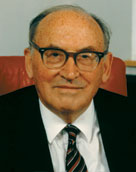
In 1955, Maurice Wilkes invented microprogramming, which is widely used in the CPUs and floating-point units of mainframe and other computers, such as the IBM 360 series. Microprogramming allows the base instruction set to be defined or extended by built-in programs (now sometimes called firmware, microcode, or millicode).
In 1956, IBM sold its first magnetic disk system, RAMAC (Random Access Method of Accounting and Control). It used 50 24-inch metal disks, with 100 tracks per side. It could store 5 megabytes of data and cost $10,000 per megabyte. (As of 2005, disk storage costs less than $1 per gigabyte).
Second generation -- late 1950s and early 1960s
Transistor-photo.JPG
The next major step in the history of computing was the invention of the transistor in 1947. This replaced the fragile and power hungry valves with a much smaller and more reliable component. Transistorized computers are normally referred to as 'Second Generation' and dominated the late 1950s and early 1960s. By using transistors and printed circuits a significant decrease in size and power consumption was achieved, along with an increase in reliability. For example, the vacuum tube based IBM 650 of 1954 weighed over 900 kg, the attached power supply weighed around 1350 kg and both were held in separate cabinets of roughly 1.5 meters by 0.9 meters by 1.8 meters. It cost $500,000 or could be leased for $3,500 a month. (Its drum memory was originally only 2000 ten-digit words, and required arcane programming for efficient computing. This type of hardware limitation was to dominate programming for decades afterward, until the evolution of a programming model which was more sympathetic to software development.) By contrast, the transistorized IBM 1620, which replaced the 650, was the size of an office desk. Second generation computers were still expensive and were primarily used by universities, governments, and large corporations.
In 1959 IBM shipped the transistor-based IBM 7090 mainframe and medium scale IBM 1401. The latter was designed around punch card input and proved a popular general purpose computer. Some 12,000 were shipped, making it the most successful machine in computer history at the time. It used a magnetic core memory of 4000 characters (later expanded to 16,000 characters). Many aspects of its design were based on the desire to replace punched card machines which were in wide use from the 1920s through the early 1970s.
In 1960 IBM shipped the smaller, transistor-based IBM 1620, originally with only punched paper tape, but soon upgraded to punch cards. It proved a popular scientific computer and about 2,000 were shipped. It used a magnetic core memory of up to 60,000 decimal digits.
Vs-dec-pdp-1.jpg
Also in 1960, DEC launched the PDP-1 their first machine intended for use by technical staff in laboratories and for research.
In 1964 IBM announced the S/360 series, which was the first family of computers that could run the same software at different combinations of speed, capacity and price. It also pioneered the commercial use of microprograms, and an extended instruction set designed for processing many types of data, not just arithmetic. In addition, it unified IBM's product line, which prior to that time had included both a "commercial" product line and a separate "scientific" line. The software provided with System/360 also included major advances, including commercially available multi-programming, new programming languages, and independence of programs from input/output devices. Over 14,000 System/360 systems were shipped by 1968.
Also in 1964, DEC launched the PDP-8 much smaller machine intended for use by technical staff in laboratories and for research.
Third generation and beyond, post-1964
- Main article: History of computing hardware (1960s-present)
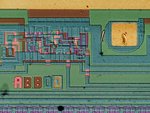
The explosion in the use of computers began with 'Third Generation' computers. These relied on Jack St. Clair Kilby's and Robert Noyce's independent invention of the integrated circuit (or microchip), which later led to Ted Hoff's invention of the microprocessor, at Intel.
The microprocessor led to the development of the microcomputer, small, low-cost computers that could be owned by individuals and small businesses. Microcomputers, the first of which appeared in the 1970s, became ubiquitous in the 1980s and beyond. Computing has evolved with microcomputer architectures, with features added from their larger brethren, now dominant in most market segments.
See also
- Computing timeline
- CPU design – includes an evolutionary history of CPU architecture and design
- History of operating systems
- History of the Internet
- History of the graphical user interface
- Programming language timeline
- Computer architecture – how computers are designed
- Computers in fiction
- Mainframe computer
- Minicomputer
- Personal computer
Links to first-generation electronic computers (use Vacuum tubes):
- BARK
- Bendix G-15
- BESK
- BINAC
- DEUCE
- EDSAC
- EDVAC
- ENIAC
- Ferranti Mark I
- Ferranti Mercury
- IAS machine
- IBM 650
- IBM 701
- IBM 704
- IBM 709
- ILLIAC
- LEO computer
- MANIAC I
- Manchester Mark I
- NORC
- ORDVAC
- PEGASUS (computer)
- Pilot ACE
- SAGE
- SARA (computer)
- Small-Scale Experimental Machine
- Standards Electronic Automatic Computer
- Standards Western Automatic Computer
- Strela computer
- TX-0
- TX-2
- UNIVAC I
- UNIVAC 1101
- UNIVAC 1102
- UNIVAC 1103
- UNIVAC 1103A
- UNIVAC 1105
- Whirlwind (computer)
Notes
- An original calculator by Pascal (1640) is preserved in the Zwinger Museum, Dresden.
- An indication of the rapidity of development of this field can be inferred by the seminal article, documented in the Datamation September-October 1962 issue, which was written, as a preliminary version 15 years earlier. (See the references below.) By the time that anyone had time to write anything down, it was obsolete.
References
- Gottfried Leibniz, Explication de l'Arithmétique Binaire (1703)
- A Spanish implementation of Napier's bones (1617), is documented in Hispano-American Encyclopedic Dictionary, Montaner i Simon (1887)
- Herman Hollerith, In connection with the electric tabulation system which has been adopted by U.S. government for the work of the census bureau. Ph.D. dissertation, Columbia University School of Mines (1890)
- W.J. Eckert, Punched Card Methods in Scientific Computation (1940) Columbia University. 136 pp. Index.
- Stanislaw Ulam, "John von Neumann, 1903-1957," Bulletin of the American Mathematical Society, vol. 64, (1958)
- Arthur W. Burks, Herman H. Goldstine, and John von Neumann, "Preliminary discussion of the Logical Design of an Electronic Computing Instrument," Datamation, September-October 1962.
- Gordon Bell and Allen Newell, Computer Structures: Readings and Examples (1971).
Books for further reading
- A History of Modern Computing, Paul Ceruzzi, 2000, MIT Press, ISBN 0-262-03255-4 (hardcover), 0-262-53169-0 (paperback)
- Bit by Bit: An Illustrated Histoy of Computers, Stan Augarten, 1984, Ticknor & Fields, ISBN 0-89919-302-1
- The Computer from Pascal to von Neumann, Herman Goldstine, 1972, Princeton University Press, ISBN 0-691-08104-3 (hardback), 0-691-02367-0 (paperback)
- A History of Computing Technology, Michael R. Williams, 1997, IEEE Computer Society Press, ISBN 0-8186-7739-2
- The First Computers: History and Architectures, edited by Raúl Rojas and Ulf Hashagen, 2000, MIT Press, ISBN 0-262-18197-5.
- Computer: A History of the Information Machine,MArtin Campbell-Kelly and William Aspray, 1996, Basic Books, ISBN 0-465-02989-2.
- Landmarks in Digital Computing: A Smithsonian Pictorial History, Peggy Kidwell and Paul Ceruzzi, 1994, Smithsonian, ISBN 1-56098-311-6
- A History of Computing in the Twentieth Century, edited by: Nicholas Metropolis, J. Howlett, and Gian-Carlo Rota, 1980, Academic Press, ISBN 0-12-491650-3
- Early British Computers, Simon Lavington, 1980, Digital Press (US) and Manchester University Press (UK), ISBN 0-932376-08-8. Available online (http://ed-thelen.org/comp-hist/EarlyBritish.html)
- ENIAC: The Triumphs and Tragedies of the World's First Computer, Scott McCartney, 1999, Walker and Company, ISBN 0-8027-1348-3
- A Few Good Men from Univac, 1987, David Lundstrom, MIT Press, ESBN 0-262-62075-8
- Portraits in Silicon, Robert Slater, 1987, MIT Press, ISBN 0-262-19262-4
- Out of Their Minds: The Lives and Discoveries of 15 Great Computer Scientists, Dennis Shasta and Cathy Lazere, 1995, Copernicus, ISBN 0-387-97992-1
- Stan Viet's History of the Personal Computer, Stan Viet, 1993, WorldComm, ISBN 1-56664-023-7
- From Dits to Bits... : A Personal History of the Electronic Computer, Herman Lukoff, 1979. Robotics Press, ISBN 89661-002-0
- Faster, Faster: A Simple Description of a Giant Electronic Calculator and the Problems it Solves, Wallace J. Eckert and Rebecca Jones, 1955, McGraw-Hill. (No ISBN, Dewey decimal: 510.8 E19f). A contemporary book about the NORC.
- The Origins Of Digital Computers, selected papers, Third Edition, Brian Randell, 1982, Springer-Verlag, ISBN 3-540-11319-3
External links
- "All-Magnetic Logic" (http://www.sri.com/about/timeline/allmagnetic-logic.html) computer developed at SRI International, in 1961
- Famous Names in the History of Computing. (http://www.algana.co.uk/FamousNames/FamousNamesFrameset.htm) Free source for history of computing biographies.
- Stephen White's excellent computer history site (http://ox.compsoc.net/~swhite/history.html) (the above article is a modified version of his work, used with Permission)
- Yahoo Computers and History (http://dir.yahoo.com/Computers_and_Internet/History/)
- Paul Pierce's computer collection (http://www.piercefuller.com/collect/)
- IEEE computer history timeline (http://computer.org/history/development/index.html)
- Konrad Zuse, inventor of first working programmable digital computer (http://www.idsia.ch/~juergen/zuse.html)
- The story of the Manchester Mark I (http://www.computer50.org/), 50th Anniversary web site at the University of Manchester
- The Moore School Lectures and the British Lead in Stored Program Computer Development (1946 -1953) (http://www.virtualtravelog.net/entries/000047.html), article from Virtual Travelog
- Logarithmic timeline of greatest breakthroughs since start of computing era in 1623 (http://www.idsia.ch/~juergen/computerhistory.html)
- Rowayton Historical Society's Birthplace of the World's First Business Computer (http://www.rowayton.org/rhs/Computers/welcome.html)
- OLD-COMPUTERS.COM, extensive collection of information and pictures about old computers (http://www.old-computers.com/)
- MIT STS.035 - History of Computing (http://ocw.mit.edu/OcwWeb/Science--Technology--and-Society/STS-035Spring2004/CourseHome/index.htm) From MIT OpenCourseWare; for the undergraduate level.
- http://ed-thelen.org/comp-hist/EarlyBritish.html "Early British Computers"]ca:Histňria de la informŕtica
es:Historia del hardware de cómputo fr:Histoire de l'informatique it:Storia del Personal Computer nl:Geschiedenis van de computer pl:Historia informatyki sv:Datorhistoria pt:História do hardware


